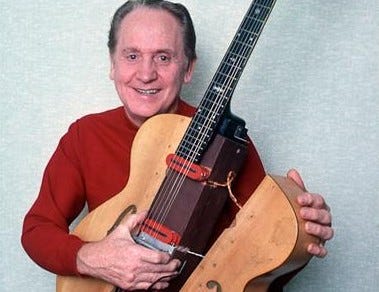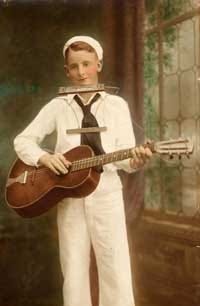Les Paul is among the towering figures of modern music. A performer for more than 80 years, he made unsurpassed contributions to the sound, scope, and design of the electric guitar. He was among the first performers to use overdubbing, delay and phasing effects, tape echo, and multi-track recording. He designed the first eight-track recorder. As noted British critic Charles Shaar Murray describes, “If anybody is the missing link between Charlie Christian and Jimi Hendrix, it’s Les Paul. He was the first person to really understand the extent to which the electric guitar was a new instrument, as different from the acoustic as a Hammond organ is from a Steinway piano–or a car from a horse.”
As a musician and inventor, Les Paul influenced many of the world’s most renowned rock and blues guitarists, including Chuck Berry, Link Wray, The Ventures, Jimmy Page, Eric Clapton, Keith Richards, Peter Green, Brian May, Joe Perry, Steve Vai, Paul McCartney, and Mike Bloomfield. As Joe Walsh once told me, “Les Paul was one of the great innovators of the early electric guitar, and he made some fantastic guitar records. To me, Les Paul is very much it.”
Les Paul likewise exerted a profound influence on jazz greats from Wes Montgomery, George Benson, Al DiMeola, and Pat Martino to Stanley Jordan, whose neck-tapping technique is highly reminiscent of some of Paul’s records. Country legends such as Hank Garland and Chet Atkins were equally quick to sing his praises. Chet Atkins first heard Les in the mid 1930s: “It was a great thrill to listen every night and hear him on NBC radio. Les played just as great then. And then later on, in the 1950s, Les Paul turned the whole world on to guitar. He’s just a terrific, flashy, tasty guitarist.”
As Les Paul was inducted into the Rock and Roll Hall of Fame in 1988, Jeff Beck echoed the thoughts of many of his peers when he introduced Les with the words, “I’ve copied more licks from this man than I’d like to admit.” Jimmy Page is equally quick to credit Les Paul: “That’s where I heard feedback first–from Les Paul. Also vibratos–even before B.B. King, you know. I’ve traced a hell of a lot of rock and roll, little riffs and things, back to Les Paul–it’s all there. I mean, he’s the father of it all: multi-tracking and everything else. If it hadn’t been for him, there wouldn’t have been anything really.”
And then there’s the guitar. Few images say “rock and roll” more vividly than the Gibson Les Paul guitar. During the past six decades, the instrument that bears Les’s name has appeared in the hands of everyone from the earliest rockabillies and the Beatles, Rolling Stones, Eric Clapton, Jeff Beck, the Allman Brothers, ZZ Top, Peter Frampton, Aerosmith, Neil Young, and Joe Walsh all the way to today’s up-and-coming rockers. It is, without doubt, the best-known artist endorsement in rock and roll history. But, as Les was fond of saying, this distinction carried a slight downside: “There’s millions and millions of people who think Les Paul is a guitar!”
Descended from German immigrants, Les Paul was born Lester Polsfuss in Waukesha, Wisconsin, on June 9, 1915. His lifelong interest in music, he told Jon Sievert in the interview for their 1977 Guitar Player magazine cover story, kicked into high gear when he was nine years old: “I was walking down the street, and I saw a sewer digger on his lunch hour open his lunch pail, dig out a harmonica, knock out the cracker crumbs, and play a bunch of tunes on it. I was fascinated by that harmonica, so I stared the guy out of it. I just stared at him. He said, ‘Here, kid, take it. Get out of here.’”
Soon afterward, one of his friends showed him how to fashion a crystal radio set, which Les used to dial-in radio broadcasts from the Grand Ole Opry in Nashville and WLS in Chicago. His musical hero in those days was Claude Moye, who performed as Pie Plant Pete. Moye, who hosted a hillbilly-themed show on WLS, played acoustic guitar and a harmonica held in a homemade rack around his neck. Backstage after a 1927 concert in Waukesha, Moye let Les hold his guitar and, seeing the boy’s fascination with the instrument, drew him some basic chord patterns. Les’s mother went right out and bought her son a Sears, Roebuck acoustic that came with a capo and a book entitled E-Z Method for Guitar.
An early photo of Les depicts him dressed as a sailor, with that acoustic guitar and a large chromatic harmonica affixed to a homemade rack. Early on, Les drew inspiration from the 1920s guitar recordings of Nick Lucas and Eddie Lang. By the 1930s Django Reinhardt had become his main influence.
From the beginning, Les was into customizing his guitar. He turned his Sears, Roebuck acoustic into a 5-string and experimented with moving its bridge around and resetting the action. Since many of his early gigs were held outdoors around Waukesha, where he was known as “Red Hot Red,” he experimented with amplifying his guitar. “First I did it with a phonograph needle,” he explained to Jon Sievert. “I took my mother’s record player apart and jabbed the needle into the guitar, and it came out the speaker. I didn’t realize it then, but I was also doing stereo back in the ’20s. The reason for that was my own ignorance. The only way I could figure out how to get amplified was to use my mother’s radio, and I could plug a mike into that. It was fine for my voice and harmonica, but I couldn’t figure out how to put another mike in there so that I could also amplify the guitar.
“Then I took my dad’s radio and hooked it all together and put one radio on one side of the stage and one on the other. Instant stereo. I just kept studying electricity and eventually figured out how to make a magnet, how to wind a coil, and what induction and capacitance are. It was fun. I built my own recording machine when I was 12.” His dad, who owned a garage, helped young Les machine parts on a lathe.
Keep reading with a 7-day free trial
Subscribe to Talking Guitar ★ Jas Obrecht's Music Magazine to keep reading this post and get 7 days of free access to the full post archives.




